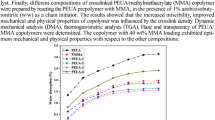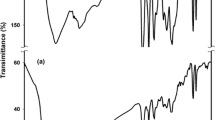Abstract
Urethane dimethacrylate (UDMA) is a monomer widely used in photopolymerization reactions to produce biomaterials, due to its advantageous properties such as mechanical resistance and relatively low viscosity. However, this monomer is expensive. Reducing the quantity of UDMA monomer required to obtain the final polymer, without losing its main properties, is essential not just in terms of costs but also green chemistry principles. It has been demonstrated that glycerol inclusion into the polymeric matrix during polymerization is one way to achieve this goal. Thus, this work proposes the insertion of glycerol and metal oxide fillers (Al2O3, TiO2, Nb2O5, La2O3 and ZrO2) in the photopolymerization of urethane dimethacrylate, with the aim to study how these effects the degree of conversion, as well as the thermal properties of the final polymer. The thermal properties were evaluated using simultaneous thermogravimetry–differential thermal analysis (TG–DTA) and differential scanning calorimetry (DSC). The degree of conversion/rate of polymerization was calculated using mid-infrared spectroscopy (MIR). The polymers filled with Al2O3, TiO2, Nb2O5 and La2O3 exhibited good conversion values of 87.42, 78.47, 77.64 and 75.51%, respectively. For all polymers synthesized, no significant changes were observed in their thermal stability. Lastly, it is suggested that the incorporation of the oxides in the monomeric mixture correlate to the degree of conversion, with scanning electronic microscopy (SEM) analysis suggesting oxide dispersion interferes with the morphology of the polymer.







Similar content being viewed by others
Code availability
Not applicable.
References
Marghalani HY (2015) Resin-based dental composite materials. In: Antoniac I. (eds) Handbook of Bioceramics and Biocomposites. Springer, Cham
Barszczewska-Rybarek IM (2019) A guide through dental dimethacrylate polymer network structural characterization and interpretation of physico-mechanical properties. Mater 12:40–57
Melinte V, Buruiana T, Balan L, Buruiana EC (2012) Photocrosslinkable acid urethane dimethacrylates from renewable natural oil and their use in the design of silver/gold polymeric nanocomposites. React Funct Polym 72:252–259
Antonucci JM, Regnault WF, Skrtic D (2010) Polymerization shrinkage and stress development in amorphous calcium phosphate/urethane dimethacrylate polymeric composites. J Compos Mater 44:355–367
Nguyen JF, Pomes B, Sadoun M, Richaud E (2019) Curing of urethane dimethacrylate composites: a glass transition study. Polym Test 80:106–113
Guo X, Cheng Q, Wang H, Yu G, Tian Z, Shi Z, Cui Z, Zhu S (2020) Synthesis, characterization, and aging resistance of the polyurethane dimethacrylate layer for dental restorations. Eur J Oral Sci. https://doi.org/10.1111/eos.12674
Xu Y, Wang H, Xie D (2018) Preparation of new low viscosity urethane dimethacrylates for dental composites. J Biomater Sci, Polym Ed 29:1011–1025
Lalevée J, Fouassier JP (2015) Dyes and chromophores in polymer science. ISTE, London
Fouassier JP, Lalevée J (2012) Photoinitiators for polymer synthesis: scope, reactivity and efficiency. Wiley, Germany
Allonas X, Lalevée J, Fouassier JP (2003) Investigation of cleavage processes in photoinitiators: from experiments to molecular modeling. J Photoch Photobio A 159:127–133
Tehfe MA, Louradour F, Lalevée J, Fouassier JP (2013) Photopolymerization reactions: on the way to a green and sustainable chemistry. Appl Sci 3:490–514
Fouassier JP, Allonas X, Burget D (2003) Photopolymerization reactions under visible lights: principle, mechanism and examples of applications. Prog Org Coat 47:16–36
Anastas P, Eghbali N (2010) Green chemistry: principles and practice. Chem Soc Rev 39:301–312
Sheldon RA (2008) E factors, green chemistry and catalysis: an odyssey. Chem Commun 29:3352–3365
Alarcon RT, Gaglieri C, Bannach G (2018) Dimethacrylate polymers with different glycerol content. J Therm Anal Calorim 132:1579–1591
Alarcon RT, Holanda BBC, Rinaldo D, Caires FJ, Almeida MV, Bannach G (2017) Synthesis thermal studies and conversion degree of dimethacrylate polymers using new non-toxic coinitiators. Quim Nova 40:363–370
Gu Y, Jérôme F (2010) Glycerol as a sustainable solvent for green chemistry. Green Chem 12:1127–1138
Análise de conjuntura dos biocombustíveis ano 2018 (2019) Ministério de Minas e Energia, Rio de Janeiro. https://www.epe.gov.br. Acessed 01 Jun 2020
Habib E, Wang R, Wang Y, Zhu M, Zhu XX (2016a) Inorganic fillers for dental resin composites: present and future. ACS Biomater Sci Eng 2:1–11
Móczó J, Pukánszky B (2008) Polymer micro and nanocomposites: structure, interactions, properties. J Ind Eng Chem 14:535–563
Turssi CP, Ferracane JL, Vogel K (2005) Filler features and their effects on wear and degree of conversion of particulate dental resin composites. Biomater 26:4932–4937
Melinte V, Buruiana T, Chibac A, Lupu N, Grigoras M, Buruiana EC (2015) Preparation and properties of photopolymerized hybrid composites with covalently attached magnetite nanoparticles. Chem Eng J 259:542–551
Chibac AL, Melinte V, Buruiana T, Mangalagiu I, Buruiana EC (2015) Preparation of photocrosslinked sol-gel composites based on urethane-acrylic matrix, silsesquioxane sequences, TiO2, and Ag/Au nanoparticles for use in photocatalytic applications. Polym Chem 53:1189–1204
Alarcon RT, Gaglieri C, de Oliveira AR, Bannach G (2018) Use of DSC in degree of conversion of dimethacrylate polymers: easier and faster than MIR technique. J Therm Anal and Calorim 132:1423–1427
Alarcon RT, Dos Santos GC, de Oliveira AR, Silva-Filho LC, Gilbert B (2019) Synthesis of luminescent polymers in the UV light region from dimethacrylate monomer using novel quinoline dyes. J Appl Polym Sci 136:47461–47468
De Oliveira DSBL, De Oliveira LSBL, Alarcon RT, Holanda BBC, Bannach G (2017) Use of curcumin and glycerol as an effective photoinitiating system in the polymerization of urethane dimethacrylate. J Therm Anal Calorim 128:1671–1682
Nimlos MR, Blanksby SJ, Qian X, Himmel ME, Johnson DK (2006) Mechanism of glycerol dehydration. J Phys Chem A 110:6145–6156
Katryniok B, Paul S, Bellière-Baca V, Rey P, Dumeignil F (2010) Glycerol dehydration to acrolein in the context of new uses of glycerol. Green Chem 12:2079–2098
Yun D, Yun YS, Kim TY, Park H, Lee JM, Han JW, Yi J (2016) Mechanistic study of glycerol dehydration on Brønsted acidic amorphous aluminosilicate. J Catal 341:33–43
Bannach G, Cavalheiro CCS, Calixto L, Cavalheiro ETG (2015) Thermoanalytical study of monomers: BisGMA, BisEMA, TEGDMA UDMA and their mixture. Braz J Therm Anal 4:28–34
Filatova EO, Konashuk AS (2015) Interpretation of the changing the band gap of Al2O3 depending on its crystalline form: connection with different local symmetries. J Phys Chem C 119:20755–20761
Kambur A, Pozan GS, Boz I (2012) Preparation, characterization and photocatalytic activity of TiO2-ZrO2 binary oxide nanoparticles. Appl Catal B 115–116:149–158
Cheng JB, Li AD, Shao QY, Ling HQ, Wu D, Wang Y, Bao YJ, Wang M, Liu ZG, Ming NB (2004) Growth and characteristics of La2O3 gate dielectric prepared by low pressure metalorganic chemical vapor deposition. Appl Surf Sci 233:91–98
Lopes OF, Paris EC, Ribeiro C (2014) Synthesis of Nb2O5 nanoparticles through the oxidant peroxide method applied to organic pollutant photodegradation: a mechanistic study. Appl Catal B 144:800–808
Salinas D, Sepúlveda C, Escalona N, GFierro JL, Pecchi G (2018) Sol-gel La2O3-ZrO2 mixed oxide catalysts for biodiesel production. J Energy Chem 27:565–572
Wang Z, Wang L, Jiang Y, Hunger M, Huang J (2014) Cooperativity of Brønsted and Lewis acid sites on zeolite for glycerol dehydration. ACS Catal 4:1144–1147
Masih D, Rohani S, Kondo JN, Tatsumi T (2019) Catalytic dehydration of ethanol-to-ethylene over Rho zeolite under mild reaction conditions. Micropor Mesopor Mater 282:91–99
Song Y, Xu S, Ling F, Tian P, Ye T, Yu D, Chu X, Lin Y, Yang X, Tang J (2017) Atomic layer deposition of aluminium on anatase: a solid acid catalyst with remarkable performances for alcohol dehydration. Catal Commun 99:34–38
Habib E, Wang R, Wang Z, Zhu M, Zhu XX (2016b) Inorganic Fillers for dental resin composites: Present and Future. ACS Biomater Sci Eng 2:1–11
Utech S, Boccaccini AR (2016) A review of hydrogel-based composites for biomedical application: enhancement of hydrogel properties by addition of rigid inorganic fillers. J Mater Sci 51:271–310
Acknowledgments
The authors thank CAPES (grants 024/2012 and 011/2009 Pro-equipment), FAPESP Grants 2017/08820-8, 2018/03460-6 and 2019/11493-4 São Paulo Research Foundation (FAPESP), and CNPq (grant 301857/2018-0) for financial support. The authors also thank Arthur Rossi de Oliveira for initiating the experiments.
Funding
CAPES (grants 024/2012 and 011/2009 Pro-equipment), São Paulo Research Foundation -FAPESP (Grants 2017/08820–8, 2019/11493–4 and 2018/03460–6), and CNPq (grant 301857/2018–0).
Author information
Authors and Affiliations
Corresponding author
Additional information
Publisher’s Note
Springer Nature remains neutral with regard to jurisdictional claims in published maps and institutional affiliations.
Rights and permissions
About this article
Cite this article
Benites, A.B., Alarcon, R.T., Gaglieri, C. et al. Effect of metal oxide fillers in urethane dimethacrylate polymer with glycerol obtained by photopolymerization synthesis. J Polym Res 27, 311 (2020). https://doi.org/10.1007/s10965-020-02292-1
Received:
Accepted:
Published:
DOI: https://doi.org/10.1007/s10965-020-02292-1




